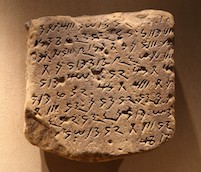- Introduction
- Index
- Further information

The Meroitic language was written beginning in the 3rd century B.C. using two distinct writing systems, cursive Meroitic and the much less common hieroglyphic Meroitic. These are two alphasyllabic writing systems, with twenty-three characters only and one punctuation mark. Meroitic became extinct in the fourth century AD with the fall of the Kushite Empire.
Go to the online resources.
Online resourcesIndex
Oral culture
Although the Meroitic language is attested from the 2nd millennium AD (through person, tribe, and place names making their appearance in written Egyptian texts), a writing system of its own does not appear until the 3rd century AD. During the flourishing Kerma period (c. 2500-1500 AD), the Kushite empire was thus administered without the use of writing, a sign of the importance of oral culture and of the reluctance to put anything in writing. The writing system (Egyptian hieroglyphic, Hieratic) was introduced in Nubia during the 18th Egyptian dynasty (1550-1292 AD) and remained in use throughout the entire period of colonial occupation (which lasted about five hundred years) to write texts in the Egyptian language. After the withdrawal of Egyptian forces between the New Kingdom and the Third Intermediate Period, at the end of the second millennium B.C., the interest in using writing quickly faded, only to emerge again in the eighth century B.C. with the so-called 25th Nubian dynasty, which went North from the heart of the Kushite empire to Egypt, reunifying and conquering it. There is no doubt that young Kushites were educated in the use of Egyptian language and writing systems during both periods.
Introduction of cursive Meroitic and hieroglyphic
After the Kushite sovereigns lost Egypt in the second quarter of the 7th century BC and returned to the Middle Nile Valley, first to Napata and then to Meroe, the Egyptian writing system and language remained in use until the 3rd century AD. They were then replaced in documents, funerary inscriptions, and royal stelae by the local language and by two new writing systems: first the so-called cursive Meroitic, derived in part from Demotic Egyptian; then by hieroglyphic Meroitic, which was independent of cursive, but partly derived from Egyptian hieroglyphs and reserved for the temple walls. The earliest cursive text that can be dated back to 200 BC and mentions the qore (king) Arnekhamani. The existence of other inscriptions whose characters seem less evolved would suggest that the introduction of cursive dates back at least to the 3rd century BC. In contrast, the earliest datable text in hieroglyphic Meroitic is the double cartouche of the qore Taneyidamani, dating back to about 150 BC. Unlike Egyptian hieroglyphic, therefore, Meroitic hieroglyphic was not introduced until after the invention of cursive.
While cursive is more interesting paleographically, traceable to at least three main phases (archaic, transitional, and late) and several subphases, hieroglyphic Meroitic was a much more stable script. Paleographic analyses allow a cursive text to be dated with a gap of about fifty years.
The last dated text in cursive Meroitic is the inscription of Kharamadoye, king of the Blemmi (410-20 AD), while the last text dated in hieroglyphic Meroitic appears on an object in the funerary objects of a Noba prince buried at al-Horbagi around 350 AD.
Writing
The Meroitic script was deciphered in 1909 by Francis Llewellyn Griffith (1862-1934), who was able to determine the correct reading direction, i.e. right-to-left, and to isolate the twenty-three characters of the cursive script. It was Fritz Hintze (1915-1993) who discovered that it was an alphasyllabic script: a vowel /a/ was always added to the consonants by default (e.g. ba, ma, na), while a modifier was added to obtain a syllable with a different vowel or without a vowel. Cursive Meroitic was the first among ancient writing systems to have punctuation marks (two or three vertical dots used to separate words). Unlike other ancient scripts, no properly bilingual text has reached us; one of the rare exceptions is a jar found among the funerary objects of Queen Nahirqo, in which a short label in Egyptian Demotic (irp n Kmy, 'wine of Egypt') is flanked by a Meroitic text (Qomo-s-o, 'this is from Egypt').
Supports
While the main distinction between hieroglyphic and Hieratic or Demotic Egyptian lies in the monumental or documentary use of the writing, this is not the case for Meroitic: in fact cursive writing is also very often found on stone. The evolution of the signs into less angular and more elongated forms suggests a constant use on supports such as papyrus paper, of which, however, very few specimens remain from Qasr Ibrim in Lower Nubia. The rest of the texts either have yet to be discovered or were destroyed due to the very humid climatic conditions of Sudan. Most of the Meroitic texts were therefore found on stone supports: stelae, walls, offering tables.
The texts
Meroitic testimonies are very few in number: just over two thousand inscriptions in about a hundred years of archaeological excavations. Forty percent of the texts are epitaphs on funerary stelae or offering tables. About twenty royal stelae engraved on sandstone or granite are also preserved. There are also several proskynemata, graffiti of worship engraved on the walls of temples by pilgrims: some are found at Philae, Kawa and Meroe. On the walls of the temples, inscriptions placed as captions to the images of gods and rulers were usually written in hieroglyphic Meroitic. They are a limited number; most were written during the reign of Candace (queen mother) Amanitore and the qore Natakamani in the 1st century BC.
Shorter inscriptions, usually on ostraca or stone shards, consist of the amuletic oracular decrees issued by Meroitic priests, of accounting records and labels on funerary objects.
Photo Gallery
List of symbols
Examples of writing
Bibliography
Map of places
